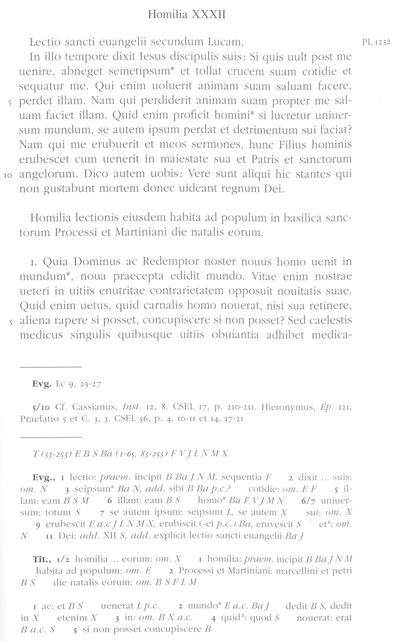Apparatus
[ æpəˈreɪtəs ]
The word is derived from the Latin apparātus (gen. apparātūs) 'preparation, equipment, instruments etc.' which is an abstract noun to the verb ad-parō 'to prepare, provide, furnish'. An apparatus (pl. apparatus or apparatuses) is a critical tool that complements the text of the editor and elucidates one or more of the following: the editorial (re)construction of the text (critical apparatus), the witnesses in which the current portion of the text is present, and the identification of source material referenced within a text. The term is most commonly used for the critical apparatus.
Critical apparatus
The term apparatus criticus may have been used for the first time in Bengel's book title D. Io. Alberti Bengelii Apparatus criticus ad Novum Testamentum, Tubingae 1763 (cf. Timpanaro 1981, 35; Timpanaro 2005, 65). The use of sigla seems to have been widespread already in the renaissance during collation but was not used in the actual editions (which leads Flores 2002 to his claim that Heinsius might be considered the inventor of the apparatus criticus, cf. Reeve 2006).
A critical apparatus (apparatus criticus) records variants among witnesses to the text according to editorial principles, which may limit recorded readings to 'significant' variants or offer a fuller range of variant readings. Broadly speaking, it is possible to distinguish a positive apparatus, in which the instances of both accepted and rejected readings are recorded, and a negative apparatus, in which only discordant readings are noted. For example, where a text reads notae, a negative apparatus might appear as: 12 notae] uotae ABC. An example of a positive apparatus for the same scenario might appear as: 12 notae DFGLOP] uotae ABC.
Other types of apparatuses
An additional register, the apparatus fontium, may be provided to identify sources for passages in the edited text. An apparatus locorum parallelorum may indicate any similar passage which need not be a source. The apparatus biblicus is a special type of an apparatus fontium. A comparative apparatus may show differences between quoted text in a work (e.g. a florilegium) and the quoted source itself. Other kinds of apparatuses may be used to give further information about the edited text, e.g. listing marginal notes in the witnesses, or indicating parallel passages within the same work (see Giannouli 2015).
Illustration

Fig. 1. A page from the Corpus Christianorum Series Latina edition of Gregory the Great's homilies on the gospels showing an apparatus fontium as the top register of the apparatus and a critical apparatus below (from Étaix 1999, 277).
References
– Battezzato, Luigi. 2006. “Johannes Livineius (1546–1599) and the Birth of the Apparatus Criticus.” In: History of Scholarship: A Selection of Papers from the Seminar on the History of Scholarship held annually at the Warburg Institute, edited by Christopher Ligota and Jean-Louis Quantin, 75–111. Oxford: Oxford University Press.
– Étaix, Raymond, ed. 1999. Gregorius Magnus: Homiliae in euangelia. Corpus Christianorum Series Latina (CCSL), vol. 141. Turnhout: Brepols.
– Flores, Enrico, and Domenico Tomasco. 2002. “Nascita dell'apparato critico.” In: Vichiana, 4a seria, anno 4 (1/2002): 3–6.
– Giannouli, Antonia. 2015. “Critical editions and the complementary apparatuses to a critical apparatus.” Comparative Oriental Manuscript Studies Bulletin 1/1: 21–28. Accessed 11 October 2015 http://www1.uni-hamburg.de/COMST/bulletin.html.
– Pöhlmann, Egert. 1994–2003. Einführung in die Überlieferungsgeschichte und in die Textkritik der antiken Literatur. Vol. 1: Antike (1994), Vol. 2: Mittelalter und Neuzeit (2003). Darmstadt: Wissenschaftliche Buchgesellschaft.
– Reeve, Michael D. 2006. “Lucretius from the 1460s to the 17th century: Seven questions of attribution.” Aevum 80 (1): 165–184. http://www.jstor.org/stable/20861797
– Timpanaro, Sebastiano. 1981. La genesi del metodo del Lachmann. 2nd ed. Padova: Liviana. – 1st ed., Firenze: Le Monnier, 1963.
– ———. 2005. The Genesis of Lachmann’s Method. Translated by Glenn W. Most. Chicago: University of Chicago Press. – Translated from Timpanaro 1981.
In other languages
DE: Apparat, kritischer Apparat
FR: apparat, apparat critique
IT: apparato, apparato critico
AC and PR (etymology)